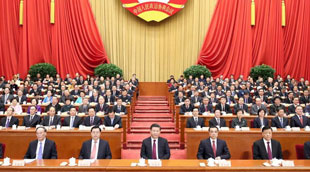
The Independent Team
The challenge behind the numbers
Belt-tightening without suffocating the patient; that is the balancing act Finance Minister Maria Kiwanuka is attempting in the 2012/13 financial year budget. It will not be easy.
For the first time in two decades, the minister of Finance is unable to report phenomenal GDP growth. But she will not give up and will be reporting a nominal GDP growth rate of 3.2%. In reality, if the figure is discounted for inflation, exchange rate shifts, and population growth, real growth is likely to be either zero or negative.
Total resource flows for the budget will be Shs 10,246.3 billion, an increase of a mere Shs 103.5 billion above this financial year, which is statistically negligible. Uganda Revenue Authority collections will also increase only marginally by Shs 786.7 billion to Shs 6,955 billion.

Tax revenue collections have slowed over most of FY 2011/12 and it is clear that the economy is being shocked from within and from without. Most hit has been Pay As You Earn (PAYE) a direct tax on income, VAT on imports, import duty and excise duty on imports. Corporate tax, petroleum duty, withholding tax, and VAT have sometimes recorded surpluses but have been unable to suture the leakages in other areas.
Apart from the stagnation in tax revenue collections from PAYE, VAT, or import duty and excise duty, another concern for the finance minister will be the unchanging tax to GDP ratio. Over the last decade, this ratio has remained around 12-13%. A major reason for the stagnation is that the tax collection system is not responsive to GDP growth.
Despite the finance minister’s announcements, the declining PAYE contributions will require a more directly analysis. Are more people losing jobs? Are employers falsifying the payroll? Are they hiring less? Answers to these questions might provide an early prognosis on the fate of the economy as more austerity sets in.
Global concerns
Uganda can take solace from the global reality. Europe and America are grappling with the same problem of receding GDP growth, spiraling inflation, and austerity, albeit for different reasons. The rich economies introduced austerity because their debt-driven living large has finally punctured their national coffers. Uganda on the other hand, is battling inflation because too little has been produced to feed growing local and regional demand in terms of food, fuel, and dollars. The two situations, therefore, although similar, might require different interventions.
The international economic environment that has seen the IMF mark-down global growth in 2012 by almost 0.7 of a percent from 4.0 to 3.3% and with a similar decline in 2013. The downturn is particularly sharp in Uganda’s traditional trading partners, the UK (down by 1.0% in 2012) and the Euro Zone (down by 1.6% bringing them into recession).
Locally, data from Uganda Bureau of Statistics indicates that in the first quarter of this FY 2011/12, the economy grew by 0.4% compared to 3.2% in the fourth quarter of FY 2010/11 an unprecedented 700% plunge.
Slow growth
As a result, it is projected that this FY 2011/12, Uganda’s economy slowed down from 7% GDP growth rate projected at the beginning of the financial year to about 3.2% per annum compared to 6.7% registered in the previous financial year. However, the slow growth is also partly a result of austerity measures implemented by the ministry of Finance to battle marauding inflation. Both the budget and monetary policy have had to be tight.
Austerity remains on the cards as the budget is nominally kept at the same level as last year. In reality, however, the government is spending less if inflation at 18.6% and population growth rates of 3.5% p.a. As a result, the budget is attempting to ward further distress by slashing allocations by between 50% and 25% for items like advertising, public officials travel local and international, and workshops and seminars.
It is not all gloom as Thomas Richardson, the outgoing IMF Senior Resident Representative told The Independent. The expert view is that the Uganda economy could recover next fiscal year and return to real GDP growth of around 7 percent p.a. as early as 2013.
Although headline inflation swung to 30.5% between May and October 2011, which is the highest rate since 1993, it has eased to 18.6% as the budget is read and is going down. The main local inflation driver was food crop inflation which hit a record 50.4% due to reduced supplies in the markets. That has eased off.
“High inflation is a problem, and it needs to be brought down,” says Richardson, “That’s what is happening. It has some pain, no doubt about that.
“But keeping inflation high is even more costly: it undermines investment, and therefore damages long term growth. And it acts like a tax that is paid disproportionately by the poor and middle class.”
Even the exchange rate volatility, which peaked between October 2010 and October 2011 and left the shilling without 25% of its value against the dollar, has remained relatively stable in the first five months of 2012. Partly, that is a result of the government raising interest rates on securities substantially with the average 91-day TB rising by 7.3 percentage points to 17.3% and the 364-day TB at 20.1% in November 2011. The central bank also raised its bank rate to 20%, which subsequently forced commercial banks to up their lending rates.
Energy boost

The Finance Minister will pin high hopes on the performance of the energy sector where completion of the Bujagali Hydropower Dam is pushing another 250MW of electricity onto the national grid. Other energy projects the have been completed include Mpanga mini hydro (18 MW), Ishasha Min hydro (6.5MW), Kisiizi (0.3MW). Others are, Bugoye (13 MW); Mobuku I (5 MW; Mobuku III (9 MW); Kakira (22MW) and Kinyara (7.5MW). Together they add 68.5 MW to the national grid.
In the energy sector still, the government continues to harbor great expectations from the oil sector which in FY 2010/11, raked in a whopping Shs 1,008 billion. Although the Minister of Finance announced in 2011 that the government was “finalising the appropriate legal and institutional framework for resource and revenue management” there have been a lot of movement but no tangible results. Even the preliminary work on the construction of the Oil Refinery near Hoima, for which Shs 14.7 billion was allocated, has not taken off. On the revenue front, although Tullow Oil successfully farmed down two-thirds of its concessions to CNOOC and Total in February, the US$472 million expected to have flown into the Uganda coffers as Capital Gains Tax is still held up. Tullow says it already paid US$141 million and is disputing the balance.
Therefore, oil revenue squabbles and the the export-constraining factors originating especially from the Eurozone are unlikely to ease in the short to medium term. As outlined in the Budget Framework Paper, the restrainedlocal revenue and export earnings, reduced remittances and foreign direct investment (FDI), are likely to depreciate currencies and foment speculative tendencies on the foreign exchange market. The balance of payments data is, therefore, expected to be dour despite efforts to rein-in imports. By October 2011, for example, the value of exports had declined by 4% while the corresponding import bill rose by nearly 8%, as compared to July 2011.


Free spenders
Finally and lest we forget; austerity as a word, has its roots in the French word `austerite’ meaning “severe self-discipline”. Do government departments like State House, Parliament, and Defense which and get supplementary budgets as a matter of course while the government runs expenditure arrears every year, know this? Or do they think austerity is for the people and not the leaders?
In his State of the Nation Address on June 7, President Yoweri Museveni expressed bitterness about what he described as “Besigye’s lawlessness” and “indiscipline,” which he said hurt the economy.
“The fujjo (chaos) and the false stories that were being sent out of Uganda scared tourists for some time. This meant less dollar inflows, dollar appreciation and more difficulties for the importers,” Museveni said as he praised the police boss, Lt. Gen. Kale Kayihura.
Taxpayer also incurred a big expense on the Police. About Shs 242 billion was allocated to the Police Force for the whole year but Shs 148 billion (63%) had already released by the first half of the financial year. Most of this went to quelling riots. More than Shs 32 billion was spent on specialised equipment and vehicles including teargas launchers in an effort to contain demonstrations and strikes. If such high costs persist, the government’s attempt to curtail public expenditure will fail.
While most ministries and government departments have faced a financial squeeze in the past 12 months, State House and Police have been on a spending binge.
State House’s budget ate up 124% of what was allocated to it in the first six months of FY 2011/12. According to the semi-annual budget performance report for the first half of the year, it was the biggest spender. Although Shs 63 billion was budgeted for State House, about Shs 79 billion was released.
The President’s Press Secretary, Tamale Mirundi, defended the expenditure saying State House is a huge institution and the money spent on it is not for the President’s personal enjoyment or on State House employees because they are “paid the lowest salaries.”
“The President is an international peace maker and has numerous projects that he supports countrywide. It is money well spent and there are no regrets to make over it,” he said.
Public administration continues to be a key liability to the economy. By mid-year, the sector had used up almost 80% of its total budget, which explains why the budgets of other ministries had to slashed to take care of the deficit in the last months of the financial year. The FY 2012/13 is likely to perform even worse as an army of lower cadre Local Council leaders are placed on the government’s payroll.
As a result, priority areas like education, health, agriculture, and infrastructure continue to be starved, which does not do economic recovery prospects any favours. The little they are offered on paper is rarely released in full. For instance, while the budget for the Education sector exclusive of donor funds for the FY 2011/2012 was Shs 1.2 trillion, only Shs 643 billion or 52% was released in the first half of the year. More than 80% of the population depends on Agriculture for their livelihoods but midway in FY 2011/12, only 47% or Shs 138.2 billion of the Sector budget had been released excluding taxes and arrears. Its poster-project, the National Agriculture Advisory Services (NAADS) boasted the highest unspent balances with only 35% of their releases spent.


 The Independent Uganda: You get the Truth we Pay the Price
The Independent Uganda: You get the Truth we Pay the Price


